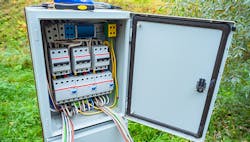As fall and, it appears, winter descend upon us in the northern hemisphere, the need to regulate the temperature in our homes has become a paramount concern. I’m sure that most of you will immediately think of your own domestic situation and how every member of the household has a unique idea of where the thermostat should be set. Usually, the one paying the electric or gas bill wins in such decisions, but there will always be one or more members of the house offering pretty valid opinions of how warm or cool the house should be.
Running the furnace with the ceiling fan blowing full tilt and the window open a crack in the dead of winter is, I’m sure, not a foreign concept to many of us. Well, as it turns out, it’s really not any different in the field of automation and control.
In the world of high-tech electronics, the need to maintain an optimal temperature inside an electrical enclosure isn’t just a desire; in some cases, it is a vital need. This value is determined by taking into consideration all of the various components that make up a control design and coming up with a happy median between the need to keep devices cool without plunging them into negative behavior of being too cold or irrational behavior from being too hot.
The usual term for the temperature around a piece of equipment is ambient or baseline temperature. This is the environment outside of the enclosure and is very important because a good deal of temperature regulation happens as a result of the difference in temperature between the inside of the enclosure and the temperature outside the enclosure. The larger the enclosure, the more surface area comes into play and can affect the regulation in two ways. If the ambient temperature is higher than the internal temperature, the internal temperature will rise. If the ambient temperature is lower, the internal temperature will also be lowered because natural convection tends to draw off the heat.
Other considerations of how the generation of heat inside an enclosure can impact the regulation of temperature are the proximity of heat-generating devices to other similar devices and the amount of air circulation in and around the components in the panel. For instance, a DC power supply generates heat at the component level. For this reason, the device enclosure has cooling vents to allow that generated heat to evacuate the immediate vicinity of the power supply, but it contributes to the overall temperature of the enclosure. The contribution is minimal but should be noted. A variable-frequency drive (VFD), on the other hand, generates a lot of thermal energy and, for this reason, usually includes its own ventilation fan in addition to the usual venting slots in the housing. While the VFD might be cooled by the ventilation fan moving air across its internal components, that same fan is also moving hot air onto adjacent components and may negatively impact the performance. On a positive note, however, having one or more ventilation fans inside an enclosure means that air is constantly being moved around the enclosure and, at some point, the air inside the enclosure will reach a thermal balance or ambient temperature.
The layout of the components in an enclosure should take into consideration the presence of cooling fans, and the designer can make use of this feature to create an effective means of moving air inside the enclosure to prevent any one area from being too hot.
For this reason, many designers will take into consideration that hot air rises and put their variable-frequency drives near the top of the panel, knowing that during normal operation, the component-based fan will cycle to keep the device cool. A fan running in the top of the panel will force hot air down and will create a convection cycle within the enclosure.
While thermal conduction and keeping air moving in an enclosure are important, in many cases this isn’t enough and a formal study/calculation is required to determine if an additional source of heat regulation is required.
Most, if not all, enclosure manufacturers have online tools to calculate if temperature regulation is required for an enclosure. The calculation starts with the size of the enclosure. This is converted into the surface area of the enclosure.
Next, the minimum and maximum ambient, or outside, temperatures and minimum and maximum internal temperatures are entered. The internal heat load—heat generated by internal components—in Watts, is considered.
This is usually the hardest part of the equation but some assumptions or rule of thumb can be helpful. The best one is that, of the power produced by a panel, 10% of it is dissipated as heat.
Let’s run a quick example. You have a 60-by-30-by-12-inch panel that has a total 15 hp in VFDs and 150 Watts of module power.
15 hp x 746 W/hp = 11,190 W plus the 150 W = 11,340 Watts, giving off 1,134 Watts of heat.
Total surface area of the enclosure is 40 sq ft. Let’s assume there is a 10 °F difference between inside temperature and outside temperature; then a 3.3 conversion factor yields the external heat load to be 40 x 3.3 x 0.293 (BTU/hr = 1 W), or 39 W. Total heat load is 1,134 + 39 = 1,173 W.
This would mean that the heat load needs to be dissipated by means other than thermal conduction via the surface area of the enclosure. The point of this exercise was to show that the considerations involved in accurately calculating thermal load/regulation are involved.
Also read: Which panel design standards are relevant?
The example completely glossed over the “other” items in the enclosure, but they are just as important to the overall equation and should not be ignored.
The thermal regulation of an enclosure is an important part of maintaining the optimal operating environment for the components that make up the control system. The example above was a situation where reduction in heat was required, but it could easily have been a situation where the panel was located outside where the ambient temperature may get as low as the freezing point in winter months and more than 100 °F in the summer.
Regulation isn’t just about cooling and may require a solution where both heating and cooling are necessary. Much like your home, proper temperature regulation involves sensing the temperature inside the enclosure and making an informed decision to engage a heating or cooling device to bring the enclosure to the desired temperature.
Due to the complex nature of ambient environments, the solutions for regulating the temperature in an enclosure are just as varied. In a dry, non-combustive environment where the temperature outside the environment never dips below the internal temperature, the solution may be as simple as an incoming vent and an exhaust fan to draw outside air into the enclosure and pull it back out through the exhaust.
In a dusty environment with the same relative temperatures, the enclosure would need to be sealed, and cooling could only be achieved by using a heat exchanger or an air conditioner. In an environment similar to the last one but with the risk of humid air getting inside the enclosure, the solution may involve both a heat exchanger and a heater to dry out the air in the enclosure.
There isn’t a one-stop-shopping version of this. Each situation should be evaluated separately. Purge and pressurizing systems can be used to control the temperature in a panel as the introduction of an inert gas to a panel and releasing it to outside the enclosure will take warmer air—gas—out with it. Venturi systems can be used to cool some enclosures to as close as +/- 3 °F of desired by hooking up compressed air.
The best control design can fail if the environment where the components live becomes inhabitable. I have run into situations in the past where overlooking this important step has brought undesirable results.
There was a new aluminum smelter plant being built in rural Quebec, Canada. At the time, it was the largest automation project in North America. Now, to think of a smelter—melting ore to make aluminum ingots—one might imagine something akin to the bowels of a volcano—extreme high temperatures with liquid metal splashing everywhere.
While that was true of the inside of the building, the outside environment, in the dead of winter was literally the polar opposite with temperatures approaching and dipping below -40 °F on a regular basis. Coincidentally, -40 is the temperature at which the Celsius and Fahrenheit scales correspond, so -40 °F is also -40 °C, for those who didn’t know.
The company I was working for provided much of the ore-handling equipment for the project, including the crane system that moved the raw ore off rail cars and onto the conveying system that moved the chunks into the main building of the facility.
The rail cars were drawn into an outbuilding where the crane would offload—an outbuilding at -40 °F or less during winter months.
The controls for the crane were in a nice warm room with windows that looked out over the operation. Not so for the sensors that talked to that control system. We had a heck of a time trying to figure out why the photo eyes weren’t correctly indicating the various stop positions for the crane.
When we got all bundled up and went out into the night—did I mention it was cold?—to look at the sensors, they appeared to be working. Lights were on and changed state when an object blocked the path, but there was nothing at the PLC. Well, as it turns out, it was so cold out in the train shed that the electronics inside the photo sensor wouldn’t change state to send the signal back to the PLC when triggered.
Short story—we had to add enclosures around each of the photo sensors and include a thermostat-controlled heater in each enclosure to keep the sensors above the minimum operating temperate to make them work reliably.
The bottom line is to keep the environment around the components at the peak optimal parameters to ensure proper function. With the months of planning, during nice warm summer months in beautiful Montreal, Quebec, we had overlooked the now-obvious fact that it gets cold in the winter, and not all of the components of a control design will be in a nice, people-friendly environment when the work needs to get done—a lesson learned from 1999-2000 that I carry with me to this day.
Rick Rice is a controls engineer at Crest Foods, a dry-foods manufacturing and packaging company in Ashton, Illinois. With more than 30 years’ experience in the field of automation, Rice has designed and programmed everything from automotive assembly, robots, palletizing and depalletizing equipment, conveyors and forming machines for the plastics industry but most of his career has focused on OEM in the packaging machinery industry with a focus on R&D for custom applications. Contact him at [email protected].
About the Author
Rick Rice
Contributing Editor
Rick Rice is a controls engineer at Trew Automation, a material handling manufacturer based in West Chester, Ohio. With over 38 years’ experience in the field of automation, Rice has designed and programmed everything from automotive assembly, robots, palletizing and depalletizing equipment, conveyors and forming machines for the plastics industry but most of his career has focused on OEM in the packaging machinery industry with a focus on R&D for custom applications.

Leaders relevant to this article:


